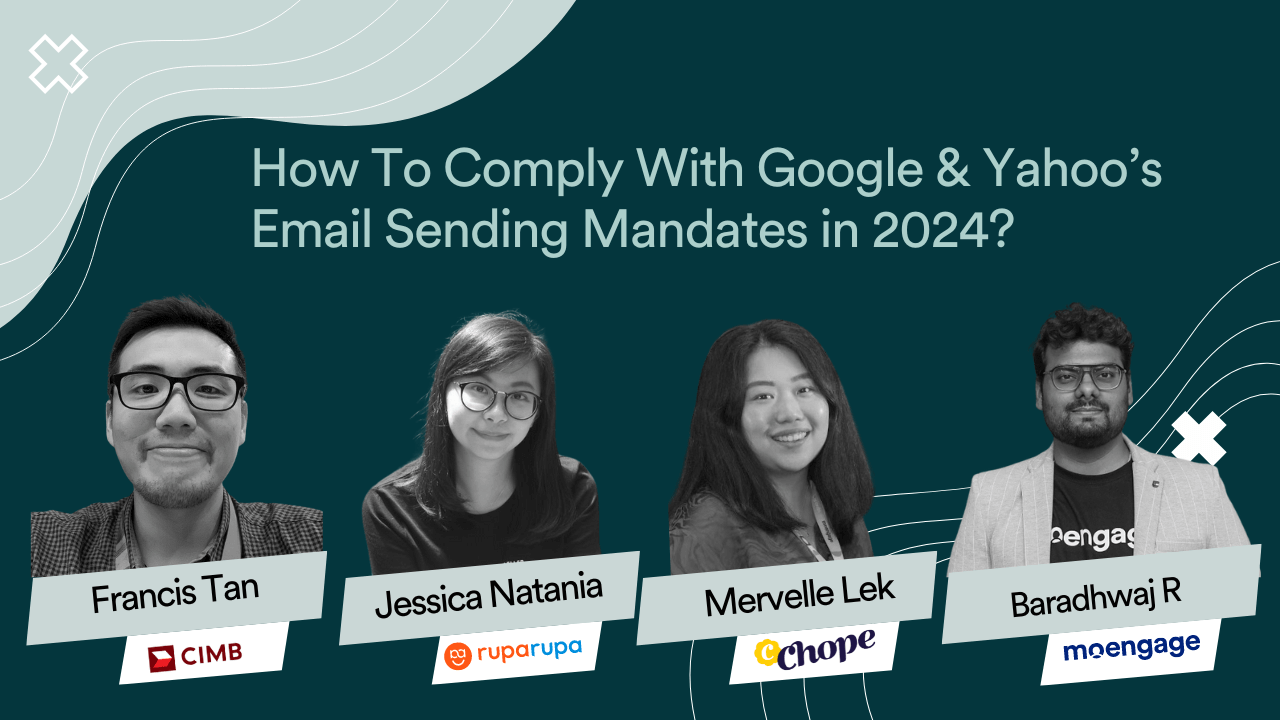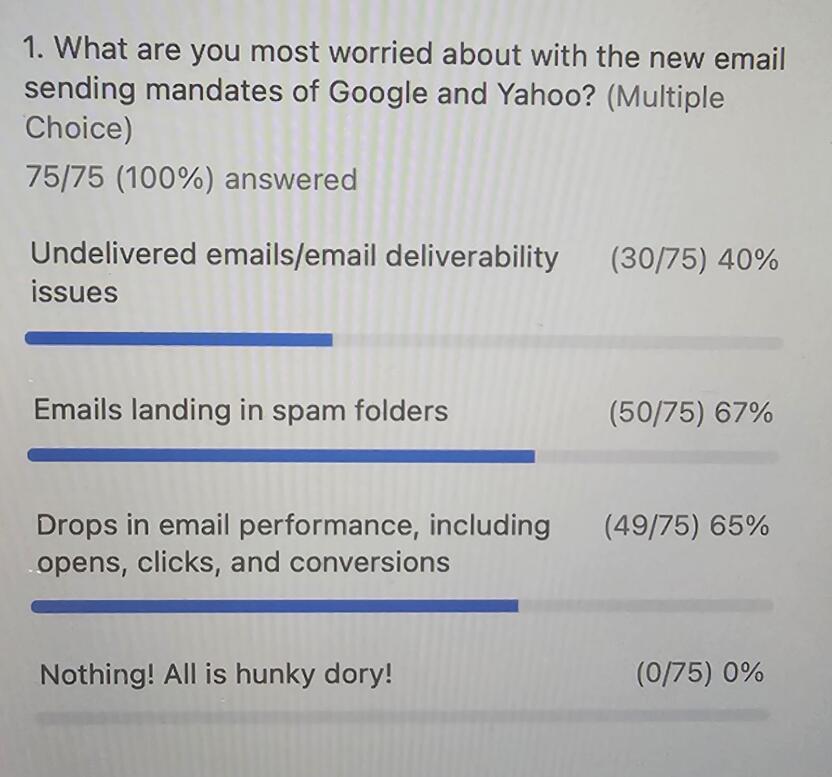Insights from CIMB, Chope & Ruparupa from the recent #GROWTH Masterclass on the new email sending mandates

Reading Time: 7 minutes
Ah, the good old email!
One of the earliest sources of digital communication that is still super relevant to businesses and people all over the world, email is the channel of choice for business communication, corporate news, marketing and promotions, and, of course, spam.
Our good friends at Google and Yahoo understand the importance of email, and the annoyance brought on by spam, unsolicited communications, and email fraud. To mitigate that, new policy updates are brought on to ensure your inboxes (and ours) remain as clean as we keep our houses when guests are visiting.
In this context, the latest Google and Yahoo email-sending mandates for 2024 are game-changing. These digital leaders who host most email inboxes in the world are tightening the noose around spammers and other bad actors in the email industry. Still, even well-meaning companies could bear the brunt of having their emails partially or completely junked if they aren’t careful.
So, what are these guidelines, and what should companies do to ensure 100% compliance?
The Guidelines
The new guidelines for emails by Yahoo and Google could be summarized as the below commandments:

- Thou shalt authenticate all thy emails using SPIF, DKIM, and DMARC: This helps the receivers rest assured that emails coming from you are truly yours and not some spammer.
- Thou shalt make unsubscribing easy: If your recipients feel spammed, they should be able to unsubscribe easily or one-click unsubscribe whenever they want.
- Thou shalt adhere to the spam-rate threshold at all times: Your domain’s spam complaint rate should remain below 0.3%, proving that you send emails only to your intended audiences and are not spamming people.
What is the most important thing to do when a new law is enforced? Ensure that you’re compliant with it, of course. With the new email guidelines, the good news is that brands that uphold the highest standards of email marketing and communications are already compliant.
But brands that haven’t been compliant in the past have the chance to kill two birds with one stone – not making Google and Yahoo penalize them whilst also improving the quality and outcomes of their email marketing strategy.
In our recent #GROWTH Masterclass on Feb 29, 2024, we asked email marketing professionals what concerned them the most about the new email-sending guidelines. Their top picks were as follows:

Now, let’s look at what our expert panelists had to say about how you can address the above concerns despite the new guidelines set by Google and Yahoo.
Understanding The Mandate & Its Impact
According to Baradhwaj (Brad), Director of Marketing at MoEngage, the mandate necessitates stronger authentication, full IP lookup, a one-click unsubscribe feature, and ensuring spam complaints are below the threshold of 0.3%. The ramifications for non-compliance seem substantial; non-compliant email traffic will start experiencing issues from February 2024, and by June 2024, all non-compliant emails will be rejected outright – a drastic measure that’s understandably causing marketers worldwide some sleepless nights.

Adapting To The Mandate & Risks
Francis, Head of Digital Marketing at CIMB, equates this abrupt move to unexpected changes in road traffic rules – and the first step to adaptation is reducing speed and understanding the changes. He explains how digital marketing has always been about learning, adapting, keeping up, and innovating – and the need for marketers to have the agility to continuously learn and adapt, not just in content and channels, but with compliance as well.
He advises businesses to enhance their email authentication with SPF, DKIM, and DMARC records while also focusing on increasing content personalization to drive up engagement rates – not just because email platforms are mandating it, but simply because it’s the secure thing to do.
The Role of Advanced Tech in Compliance and Efficiency
Jessica Natania, a Senior Customer Specialist at Ruparupa, praises technology as the co-pilot, easing navigation through the turbulent storm of compliance regulations. Adopting advanced email marketing tools allows businesses to automate compliance checks, manage subscription preferences, ensure authentication standards are met, and perform automatic spam checks. Moreover, using tech to understand customer behavior helps businesses personalize email content to gain better engagement and reduce unsubscribes.

Hyper-Personalization and Segmentation For Customer Engagement
Francis also shed light on the significance of understanding customer behavior trends and the importance of segmentation in industries such as banking. Personalization and Segmentation can lead to substantial improvements in engagement rates while simultaneously maintaining compliance. He likens outdated email marketing tactics to fashion faux pas, emphasizing the importance of staying updated and adopting techniques such as Google’s recently introduced BIMI (Brand Indicators for Message Identification) standard to raise brand visibility in inboxes.
Engagement Strategy for Dormant Subscribers
To revive dormant customer engagement, Mervelle, Regional Marketing Manager at Chope, recommends strategies likened to rekindling old friendships. For example, campaigns highlighting missed content paired with exclusive incentives, or leveraging humor to spark curiosity, can crank up customer interest and re-ignite customer engagement. Mervelle also highlights that it’s okay to talk to your customers less frequently, but when you do, make it count!
Addressing Complaints and Bounces
In line with a digital hospitality analogy, Jessica suggests handling email complaints and bounces gracefully, as a good host would at a party. She compares spam to someone not liking your party, and email deliverability to someone not being invited to your party. As a good host, you would want to understand why they didn’t receive the invite in the first place or don’t like coming to your party and rectify it for them and for the benefit of your other guests. It’s critical to use feedback loops promptly to resolve complaints and maintain a clean list by removing bounced emails.

Ensuring Authentication and Avoiding Non-Compliance
To avoid non-compliance, Brad advocates for businesses to work on building a solid online reputation, following a steady email schedule, avoiding spam traps and blacklists, crafting accurate and relevant content, amongst others. Brad also emphasizes email authentication and suggests selecting a proper infrastructure for the task.

Content That Captivates Subscribers
Mervelle discussed the importance of creativity in email content, with storytelling being an essential tool for engagement. She suggests leveraging AI-powered insights from customer engagement platforms to build resonating narratives and highlights the importance of quirky and interesting subject lines to boost email open rates.
She gives the example of Chope, and how something as physical as dining needs to feel personalized to customers over an online channel like email. She highlights how they understand customer’s cuisine or location preferences based on their past dining experiences, past bookings or browsing behavior, and from there they tailor the recommendations. At the same time, they are also aware that customers would always be open to new experiences, so they also sprinkle sections of ‘people with similar interests as you have also tried out’ across the email.
Mervelle highlights that while this level of personalization is a must, it may take time to achieve, especially at scale. Which is why she advocates using an AI-powered engagement platform like MoEngage to help tailor these recommendations for different segments of their customers, in a scalable manner!

Establishing Optimal Sending Frequency
Mervelle maintains that managing email frequency is like tuning a musical instrument—it must be ‘just right.’ This could be achieved by offering frequency choice options at the point of subscription, using AI to predict optimum sending times, or analyzing subscriber engagement metrics to understand preferences.

A/B Testing For Superior Insights
Though a 2024 party may seem a long way off, Francis illustrated the necessity of aggressive A/B testing to ensure quality email engagement. Recounting a CIMB testing experience, he shared how he wanted a more sophisticated route, while his team wanted to go for the more humorous, casual type of material. Guess which material performed better? The latter! Francis highlighted that our job as marketers is not to be right but to deliver results!
He also shared two key A/B Testing methods that he has used. One involves A/B testing one of your campaigns, learning from the results, and applying them to subsequent campaigns. Making A/B Testing a way of life is something he swears by as an always-on marketing strategy. He recommends not just doing it for a single campaign but for every campaign that you plan on executing—this paves the way for continuous refining and redefining.
Key Fixes For Better Email Deliverability
Brad demonstrated a simple hack to check if your domain authentication to achieve better deliverability of emails. He reiterated the importance of the different authentication protocols and if they are not set, he recommended talking to your email service provider. He added the implications of shared IP addresses by legacy systems and how they can be a huge gamble based on whether the other party is adhering to all the rules and regulations.
Additionally, he advised to, segment like your life depended on it, send emails only to intended recipients, make unsubscribing easy, stick to a consistent schedule, and craft personalized content. Brad also showcased how you can track spam rates in real-time using the MoEngage platform.
Brad also emphasized the need for your audience to choose the kind of emails they would still like to receive rather than unsubscribing the domain, which impacts receiving transactional emails. You can use that opportunity to understand if sending frequency is the problem—if yes, you can get input from the customer on how frequently they would like to be contacted.
You can watch the complete masterclass here:
Conclusion
And there you have it: actionable insights to ace these new email standards and turn potential challenges into opportunities! Special thanks to our expert panelists for their insights and advice. With careful planning, strategy realignment, and technological implementation, complying with the new rules needn’t seem like a daunting task. Armed with these insights, businesses can navigate seamlessly through this disruption to emerge with optimized email marketing campaigns and improved customer engagement in this new era. Don’t underestimate the humble email; it’s still one of the most powerful tools in your marketing kit.













